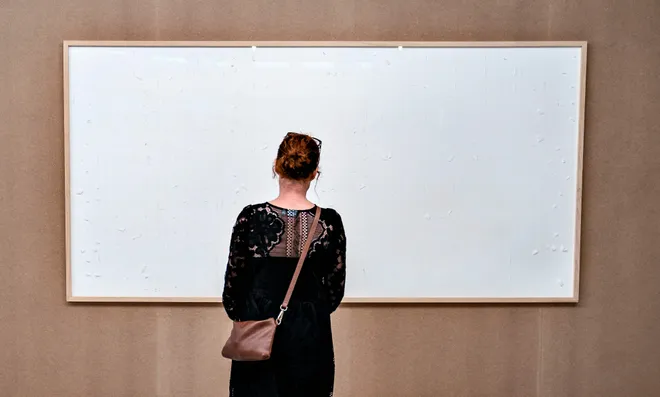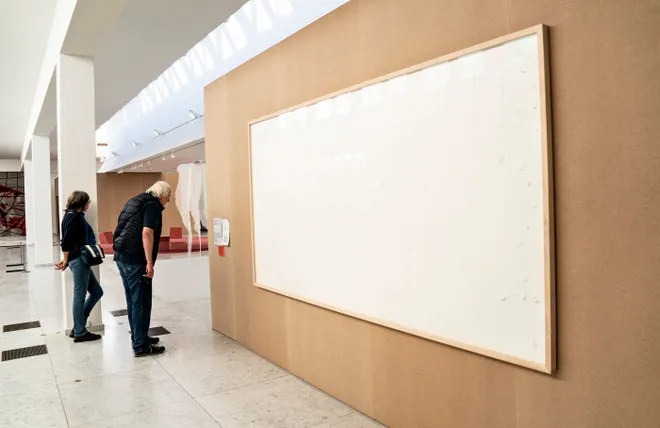A Danish artist submitted blank frames as artwork. Now, he has to repay the museum
In 2021, an art museum in Denmark commissioned a conceptual artist to create a piece reflecting wage differences within the European Union — and even sent him scores of cash with which to do it.
But the curators of the Kunsten Museum of Art in the western city of Aalborg may have gotten more (or, more accurately, less) than they bargained for when Danish artist Jens Haaning had another idea in mind. When museum staff opened the boxes Haaning sent to inspect the artist's works, they were surprised to see the money was not incorporated into the installation as intended.
In fact, the canvasses didn't display anything at all: They were completely blank.
In that moment, it became clear that Haaning's new title for the artwork, "Take the Money and Run," may have been meant quite literally.
Pop-up concert:U2 shocks Vegas fans with show on Fremont Street ahead of MSG Sphere residency
Court rules that Haaning must return the money

Haaning may have duped the museum by pocketing the cash, but this week a court in Copenhagen ruled that he wouldn't be making off with the money after all.
The court on Monday ordered Haaning to repay most of the money, approximately $70,600, as well as about another $11,000 in court fees. That restitution accounts for most of the money that was loaned to the artist to create the artwork, but the court said he should still be paid his commission fee.
"I am shocked, but at the same time it is exactly what I have imagined," Haaning told Danish public broadcaster DR on Monday.
Psychedelics:Wiz Khalifa launches mushroom brand MISTERCAP'S
Art museum commissioned Haaning to recreate earlier works

The art museum located in northern Denmark had commissioned Haaning in 2021 to recreate two earlier works that used banknotes affixed to a canvas in a frame to represent annual average salaries in Denmark and Austria.
Haaning’s 2007 work, "An Average Danish Annual Income," displayed krone notes attached to framed canvas, while a second 2011 work about Austrian incomes similarly used euro bills. The sizable gap between the incomes was meant as a commentary on the wage differences within the European Union.
To create the installation, the museum had given Haaning a loan of 532,549 Dutch krone, the equivalent of about $76,400, along with a commission fee. It was always intended as part of an agreement that Haaning would return the loaned bank notes after the exhibit concluded, according to the museum.
Instead, Haaning pocketed what amounted to approximately $84,000 in Danish kroner and euro banknotes and sent the museum two blank canvasses with a new title for the exhibit: "Take the Money and Run."
"The work is that I have taken their money," Haaning told Danish radio in 2021. “It’s not theft. It is a breach of contract, and breach of contract is part of the work.”
'American Horror Story:'Return of 'American Horror Story: Delicate' is almost here: Cast, how to watch Season 12
Museum displays art work, but still takes legal action
The stunt was unexpected to museum officials.
Before the exhibition was to open, staff at Kunsten received an email from Haaning explaining that rather than the works he agreed to create, he had made something else instead with the new title, the museum said in a Monday media release.
When staff opened the transport boxes, they found the framed canvasses devoid of not just the bank notes, but anything at all.
The museum displayed the blank canvasses nonetheless among works by other contemporary artists.
And Haaning's meaning behind the work didn't appear to be lost on the Kunsten Museum's curators. In its exhibition guide, the museum described "Take the Money and Run" as a recognition that works of art are "part of a capitalist system that values a work based on some arbitrary conditions."
"The work can therefore both be seen as a critique of mechanisms internal to the art world, but at the same time points to larger structures in our society that treat everything as a commodity," the museum wrote. "Even the missing money in the work has a monetary value when it is named art and thus shows how the value of money is an abstract quantity."
But when the exhibition was over and Haaning had not returned the loaned money as agreed in the contract, Kunsten filed a civil lawsuit.
“We are not a wealthy museum," Lasse Andersson, the director of the Kunsten Museum, told the Guardian at the time. "We have to think carefully about how we spend our funds, and we don’t spend more than we can afford.”
The court's judgment deducted roughly $5,700 from the full loan amount to serve as Haaning's artist's fee and viewing fee.
Eric Lagatta covers breaking and trending news for USA TODAY. Reach him at elagatta@gannett.com.
Disclaimer: The copyright of this article belongs to the original author. Reposting this article is solely for the purpose of information dissemination and does not constitute any investment advice. If there is any infringement, please contact us immediately. We will make corrections or deletions as necessary. Thank you.







